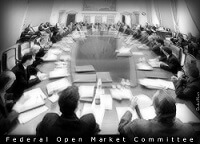We have a Federal Reserve lack of transparency problem.

In the Federal Open Market Committee's (FOMC) latest policy statement made yesterday, the institution said the U.S. economy is expanding at a "moderate pace," as consumer spending and business capital investment have risen at "solid rates."
While these words do give investors something to go on, they're still vague statements. They don't provide any tangible answers, and they are doled out unilaterally, with no press conference in which questions can be asked.
In fact, the difference between language in the September and October statements was simply a switch from "determining how long to maintain" low rates to "whether it will be appropriate" to hike.
FOMC statements alone aren't the only problem contributing the Fed's lack of transparency - they are really part of a larger issue...
A Look at the Federal Reserve Lack of Transparency Problem
Over the past two decades, the Fed has tried to evolve from an absolutely secretive institution to one committed to transparency.
But it isn't working.
Money Morning Chief Investment Strategist Keith Fitz-Gerald, a 34-year seasoned market analyst and professional trader, has long been vocal about the U.S. Federal Reserve's lack of transparency.
"I've said for years (many of which I was a lone wolf in the wilderness) that the Fed is not transparent, that it has harmed markets more than it has helped them, and that it has done absolutely no good for the American public and global financial markets," Fitz-Gerald said on Sept. 25.
The Fed has two major factors that obfuscate onlookers.
The first is its flawed concept of "forward guidance."
"Forward guidance" is a policy that was created to help stabilize the markets from even the slightest shakeup. Central banks express, or "guide," the expectations of investors and economists about the future path of policy via communicated forecasts.
But even the best intentions sometimes fall flat.
"The Fed has sent very mixed messages that, rather than provide clarity and transparency, have left us more confused than we've ever been," Craig Erlam, senior market analyst at Oanda, told The Wall Street Journal on Tuesday. "[Yesterday's FOMC statement was] the Fed's last opportunity as a collective to convey a clear and consistent message that will then be priced in to the markets so as to avoid any shocks in December, which it will be keen to avoid."
The vagaries in these statements often send U.S. markets into periods of volatility. Last month, for example, investors headed into trading on the day the U.S. central bank was either expected to announce plans to hike rates for the first time in nine years, or to offer guidance as to when the next increase might come (that day was Sept. 17). But neither happened. The Standard & Poor's 500 Index traded up as much 1.3% during that day's session, but by close it had fallen 0.3% due to the Fed's juke, reported Barron's on Sept. 19. The sell-off continued into the next day on Friday, with the S&P 500 tumbling 1.6% to finish the week at 1,958.08.
The Fed's second major transparency problem is there are too many Fed officials making different statements at the same time.
Michael Belongia, a professor of economics at the University of Mississippi, pointed out in an economic21.com post on Wednesday that lately, various Fed officials have given speeches calling for very opposite policy outcomes.
For example, Minneapolis bank president Narayana Kocherlakota stated that the Fed should lower rates on Oct. 8, while San Francisco bank president John Williams called for higher rates by the end of the year. These opposing statements, wrote Belongia, could be indicative of riffs within the Fed Committee. He suggested "hawks' on the Committee may use their speeches to promote monetary tightening, while 'doves' do so to endorse accommodative policy.
Market reaction to these statements reflects the public's changing judgments of what is being debated and disclosed by these officials. This "Fedspeak," Belongia stated - and the subsequent market reactions - are clear indicators that the FOMC still has a long way to go when it comes to expounding its intentions.
Find us on Twitter @moneymorning.
Oops. Valeant Pharmaceutical's recent drop is a stark reminder of why it's important to know what's in an ETF before making an investment. Here are seven biotech ETFs that have been crushed by the Valeant stock price drop and three biotech ETFs that don't invest in Valeant if you're looking for another play...
Related Articles:
- The Wall Street Journal: Morning Money Beat Europe: Fed Shadow Lurks Over Markets
- Forbes: About Fed Transparency: They Can't Signal What They Don't Know


